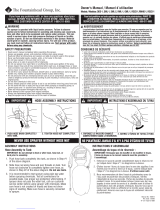
7E
STORING / MAINTAINING YOUR SPRAYER
• The sprayer should be stored out of direct sunlight in a cool dry space.
• Before freezing weather make sure to drain all liquid in the tank, pump, pressure cylinder, hose,
shut-off valve, wand and nozzle, to avoid liquid expansion and cracking in the sprayer components
(See “Cleaning” section). Lock the shut-off valve in the “open” position.
• When service is required call your nearest dealer and always insist on original manufactured
replacement parts.
• Inspect the hose, wand, pump, tank and shut-off valve for wear, damage or leaks on a regular basis
and repair defects promptly.
TROUBLE SHOOTING YOUR SPRAYER
Symptom Possible Reason Correction
Difficulty actuating the pump
lever and/or pump handle
moves itself back up.
Upper valve plate sticks Clean or replace valve plate
Piston cylinder outlet passage clogged Clean piston cylinder outlet passage
Little or no resistance during
repeated pumping – no
pressure.
Damaged/worn/dirty/upper and or lower
valve plate
Clean or Replace Valve Plate
Damaged /worn upper o-ring on piston Replace O-ring
Piston Collar or piston cylinder assembly is
worn
Replace Collar or Piston cylinder
assembly
Too much resistance after just
a few pumping strokes but
pressure only lasts briefly.
Not enough air cushion in the pressure
chamber
Release pressure in pressure chamber.
Remove the hose & drain pressure
chamber. Reconnect the hose.
Upper valve plate damaged/worn/dirty Clean or replace upper valve plate
Upward pumping action is more
difficult and/or pump handle
moves itself backdown.
Vent hole is clogged Clear the vent hole in cap.
Lower valve plate sticks Clean or replace the valve plate
Clogged filter Clean in tank filter
Piston cylinder intake clogged Clean piston cylinder intake
When the handle is pulled up it
moves itself back down
Valve Plate sticking Clean or replace valve plate
Leaks at Piston Cylinder Damaged/worn/Dirty Collar Clean or Replace Piston Collar
Damaged Piston Cylinder Replace Piston Cylinder
Damaged Piston Replace Piston
Shut-off leaks Connections loose Tighten connection.
Worn or damaged shut-off Rebuild or replace the shut-off valve.
Wand assembly leaks Connections loose Tighten connection.
Damaged or worn o-ring/gasket Replace o-ring/gasket.
Nozzle assembly leaks Connections loose Tighten connection.
Damaged or worn o-ring/gasket Replace o-ring/gasket.
Leak between pump
assembly and tank
Pump clamp loose Tighten clamp.
O-ring worn or damaged Replace pressure chamber o-ring.
Hose leaking at tank outlet Hose clamp loose Tighten clamp.
Hose leaking at shut-off Connection loose Tighten retaining nut.
Damaged or worn o-ring/gasket Replace o-ring/gasket.
Chemical tank doesn’t stay in
place
Bracket Spring is not tight Tighten spring tension bolt
Chapin Backpack Sprayer Operator’s Manual - English




















